DOWNLOAD NEWS 2014/6
by Kirk McElhearn and Brian Wilson
Download News 2014/5 is here and the index of earlier editions is here.
Welcome on board this month to Kirk McElhearn.
Index of recordings reviewed or mentioned in this edition:
BACH CPE Piano Works Vol.16_Wq62_Markovina - Hänssler
BACH Lutheran Masses Vol. I - The Sixteen - Coro
BACH Lutheran Masses Vol. II - The Sixteen - Coro
BARBER Symphonies 1 and 2 - Alsop - Naxos/2xHD
BERLIOZ Symphonie Fantastique - Immerseel - Zig-Zag
BOWEN Chamber Works - Gould Trio, etc. - Chandos
BRAHMS Clarinet Quintet - King - Hyperion; Manasse - Harmonia Mundi
BRAHMS Clarinet Quintet, Quartet Op.51/2 - Collins_Brodsky Q
BRAHMS Quartets Op.51/1 and 67 - Takács - Hyperion
BRAHMS String Quintets - Nash Ens - Onyx
BRAHMS String Quintets - Takács Q - Hyperion
BRAHMS Violin Concerto + BRUCH Nishizaki - Naxos/2xHD
BRUCH Violin Concerto + BRAHMS Nishizaki - Naxos/2xHD
BRUCKNER Symphony 8 - Haitink - RCO
BRUCKNER Symphony 9 - Haitink - LSO; Skrowaczewski - Oehms
BRUCKNER Symphony 9_completed - Rattle - EMI
CALDARA Requiem - Musica Fiorita - Pan Classics
CARTER Instances + IVES Symphony 2, etc. - Seattle SO Media
CORNAGO Missa de la mapa mundi, etc - Springfels - Harmonia Mundi
DUTILLEUX Symphony 1; Tout un monde - Morolt - Seattle SO Media
DUTILLEUX Tout un monde + LUTOSLAWSKI - Rostropovich - EMI
ELGAR Serenade, Enigma Variations + VAUGHAN WILLIAMS - Handley - EMI
GEMINIANI Concerti Grossi after Corelli - Banchini - Zig-Zag
GEMINIANI Concerti Grossi after Corelli, excs. - Banchini - Rewind
GERSHWIN American in Paris + IVES etc. - Seattle SO
GRAENER Orchestral Works I and II - Albert - CPO
HANDEL Coronation Anthems, etc. -Mortensen - Obsidian
HANDEL Duetti da camera - La Risonanza - Glossa
IVES Symphonies 1 and 2 - Järvi - Chandos
IVES Symphonies 2 and 3; General Booth - Litton - Hyperion
IVES Symphony No.2 + CARTER, GERSHWIN - Seattle SO - Seattle Media
LOCKE Anthems, etc. - New College - Hyperion Helios
LOCKE Broken Consort Part 1, etc - Holman - Hyperion Helios
LOCKE Broken Consort Part 1, etc - Wayward Sisters - Naxos
LOCKE etc Musick for severall Friends - Springfels - Harmonia Mundi
MAXWELL DAVIES Film Music - Cleobury - Naxos
MUSSORGSKY Pictures + RAVEL Mother Goose - Immerseel - Zig-Zag
MUSSORGSKY Pictures + RIMSKY-KORSAKOV Scheherazade - Krivine - Zig-Zag
MUSSORGSKY Pictures + Night on a Bare Mountain - Maazel - Telarc
PISTON Violin Concertos - Buswell_Kuchar - Naxos/2xHD
PURCELL Sonatas in 3 parts - Retrospect Trio - Linn
RAMEAU etc _ Jardin de Rameau - Christie - Arts Florissants
RAVEL Mother Goose Suite + MUSSORGSKY - Immerseel - Zig-Zag
RAVEL Rapsodie espagnole, etc. + SAINT-SAENS Symphony 3 - Seattle
SO
REUTTER Motets and Arias - La Gioia Armonica - Ramée
RIMSKY-KORSAKOV Scheherazade + MUSSORGSKY - Krivine - Zig-Zag
SAINT-SAENS Symphony 3 + RAVEL - Morolt - Seattle SO Media
SCHUBERT Piano Sonata 21 - comparative survey
SCHUBERT Piano Sonata 21; Wanderer Fantasia - Douglas - Chandos
SCHUBERT Piano Sonatas - Badura-Skoda - Arcana
SCHÜTZ Auferstehungshistorie - Rademann - Carus
SCHÜTZ Geistliche Chormusik - Rademan - Carus
SIBELIUS Complete Symphonies - Storgårds - Chandos
SIBELIUS Lemminkäinen Suite, Wood Nymph - Vänskä
- BIS
SIBELIUS Symphonies 1 and 3 - Elder - Hallé
SIBELIUS Symphony No.2, etc. - Elder- Hallé
SIBELIUS Symphonies 2 and 5 - Vänskä - BIS
TAKEMITSU Orchestral Music - selections - BIS
TAKEMITSU, BROUWER Guitar Music - Fukuda - Naxos
TAVENER Ikon of Light - Phillips - Gimell; Christophers - Coro
Trio Sonata in C18 England - London Baroque - BIS
VAUGHAN WILLIAMS Lark, Fantasias + ELGAR - Handley - EMI
WALTON Symphony 1; Violin Concerto - Little_Gardner - Chandos
Kirk McElhearn’s Reviews
HENRY PURCELL (1659-1695) Twelve Sonatas in Three Parts (1683)
Sonata No.1 in g minor, Z790 [6:29]
Sonata No.2 in B flat, Z791 [5:54]
Sonata No.3 in d minor, Z792 [5:50]
Sonata No.4 in F, Z793 [5:22]
Sonata No.5 in a minor, Z794 [6:10]
Sonata No.6 in C, Z795 [6:54]
Sonata No.7 in e minor, Z796 [7:21]
Sonata No.8 in G, Z797 [5:18]
Sonata No.9 in C minor, Z798 [7:47]
Sonata No.10 in A, Z799 [4:33]
Sonata No.11 in f minor, Z800 [5:52]
Sonata No.12 in D, Z801 [5:40]
Retrospect Trio (Sophie Gent (violin), Matthew Truscott (violin), Jonathan
Manson (bass viol) and Matthew Halls (harpsichord/organ)).
rec. St George's Church, Cambridge, UK, 18-20 February 2011. DDD/DSD
pdf booklet included
LINN CKD374 [73:10] – from linnrecords.com (mp3, 16- and 24-bit lossless) or hyperion-records.co.uk (mp3 and lossless). See also October
2011/2 DL Roundup.
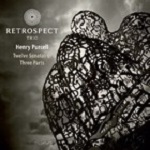 Purcell’s
music is a great way to cheer yourself up on a cloudy day. Sometimes
joyous, often exuberant, Purcell wrote simple, attractive melodies,
in delightful forms. Unlike the longer pieces by composers such as Handel
or Bach, Purcell also wrote a lot of short works. The twelve sonatas
on this release come in at six to eight minutes each, and that for as
many as six movements in a sonata, though some movements segue directly
into their followers. In the Italian style, this set of sonatas manage,
with four instruments, to sound almost like a larger chamber ensemble.
The counterpoint and polyphony are rich and intricate, and, in short
one-minute movements, Purcell does what some composers took five minutes
to do.
Purcell’s
music is a great way to cheer yourself up on a cloudy day. Sometimes
joyous, often exuberant, Purcell wrote simple, attractive melodies,
in delightful forms. Unlike the longer pieces by composers such as Handel
or Bach, Purcell also wrote a lot of short works. The twelve sonatas
on this release come in at six to eight minutes each, and that for as
many as six movements in a sonata, though some movements segue directly
into their followers. In the Italian style, this set of sonatas manage,
with four instruments, to sound almost like a larger chamber ensemble.
The counterpoint and polyphony are rich and intricate, and, in short
one-minute movements, Purcell does what some composers took five minutes
to do.
The music is both dense and simple; at times, the melodies sound like
very simple arias, but at other times they recall the complex harmonies
of Purcell’s fantasies for viol consort. The lovely sound on this recording
highlights the interplay between the instruments, and its resonance
– from St. George’s Church in Cambridge – gives the listener a lovely
feeling of space. This is definitely an album that benefits from listening
on headphones. However, I found that the harpsichord is hard to hear
when it’s played; some sonatas have harpsichord and others organ. In
the latter, the organ gives a very solid underpinning to the music,
but the sonatas with harpsichord sound more like string trios.
This wonderful recording highlights all that is great about Purcell’s
music, in small-scale works that delight in inventiveness. The luscious
sound makes it a pleasure to listen to. I only wish there was more.
There is also a recording of Purcell’s Ten Sonatas in Four Parts by
the Retrospect Trio on Linn Records that I haven’t heard yet. (CKD332 – see June
2009 DL Roundup.)
Carl Philipp Emanuel BACH (1714-1788) Complete Piano Works - Volume
16 [75.56]
Keyboard Sonata in B-Flat, Wq.62/1, H.2 [7:49]
Keyboard Sonata in G, Wq.62/2, H.20 [6:50]
Keyboard Sonata in D, Wq.62/3, H.22 [9:49]
Keyboard Sonata in d minor, Wq.62/4, H.38 [12:07]
Keyboard Sonata in E, Wq.62/5, H.39 [11:55]
Keyboard Sonata in f minor, Wq.62/6, H.40 [10:30]
Keyboard Sonata in C, Wq.62/7, H.41 [11:26]
March in D, H.1/1 (BWV Anh.122) [1:01]
Polonoise in g minor, H.1/2 (BWV Anh.123) [1:28]
March in G, H. 1/3 (BWV Anh.124) [1:13]
Polonoise in g minor, H.1/4 (BWV Anh.125) [1:48]
Ana-Mariji Markovina (piano)
rec. December 2012, September 2013, Aula Magna, Köln University.
pdf booklet included
HÄNSSLER CLASSIC CD98.003-16 [75:56] – from classicsonline.com (mp3) or stream from Naxos Music Library
 It’s
the 300th anniversary of CPE Bach’s birth this year, which is as good
a time as any to discover or re-discover his music. While his father,
the elder Johann Sebastian, is better known, Carl Philip Emmanuel was
a hugely important musician in his time. He was technically the most
accomplished of the Bach children, and had a long career, writing a
wide variety of music. Some of his most interesting music was written
for keyboard, and he wrote a treatise, the Essay on the True Art
of Playing the Clavier, which has remained an important text for
understanding performance practice.
It’s
the 300th anniversary of CPE Bach’s birth this year, which is as good
a time as any to discover or re-discover his music. While his father,
the elder Johann Sebastian, is better known, Carl Philip Emmanuel was
a hugely important musician in his time. He was technically the most
accomplished of the Bach children, and had a long career, writing a
wide variety of music. Some of his most interesting music was written
for keyboard, and he wrote a treatise, the Essay on the True Art
of Playing the Clavier, which has remained an important text for
understanding performance practice.
Pianist Ana-Mariji Markovina set out to record all of CPE Bach’s keyboard
music, based on a new edition of his works: ‘Carl Philipp Emanuel Bach:
The Complete Works’ is an editorial and publishing project of The Packard
Humanities Institute, in cooperation with the Bach- Archiv Leipzig,
the Sächsische Akademie der Wissen-schaften zu Leipzig,
and Harvard University.
She has recorded 26 volumes of this music, which is available in a box
set from Hänssler, as well as in individual downloads, such as
this. I chose one volume at random to sample these recordings, Volume
16, which contains seven sonatas written between 1739 and 1744, and
four short pieces. The playing here is energetic and delightful; Markovina
draws Bach’s sound world out of her piano – a luscious sounding Bösendorfer
– with talent and vigour, yet plays the slow movements delicately.
It’s interesting to compare these recordings to another complete series,
that by Miklós Spányi on Bis. Spányi plays most of them on clavichord,
making this one of the largest recording projects of any composer on
that instrument. I believe the Bis series will run to 35 or so volumes;
we won’t know for a few years, as he’s only up to volume 27. This is
compared to only 26 discs for Markovina. There are two reasons for this.
Markovina’s tempi are, in general, a bit faster than Spányi’s. I’m not
sure if this is because the clavichord is more difficult to play quickly,
or if it doesn’t sound good at faster tempi, but Spányi’s playing is
slower overall. And Spányi seems to play all the repeats, which Markovina
doesn’t do. (I’ve only looked at a few sonatas, but it’s likely the
case across the board.)
I’ve long been a fan of CPE Bach’s keyboard works, and own most of Spányi’s
releases; I especially like the intimate sound of the clavichord (though
the first three volumes of the series were mastered too loudly). Recently,
new recordings, such as Danny Driver’s two volumes on Hyperion, and
this set by Markovina, have gotten me more interested in listening to
these works on piano. This volume suggests that the entire set will
be worth listening to, though 26 discs of keyboard music by anyone may
be a bit much. If you are interested in the full set, I’d recommend
skipping the downloads; with the box set on CD costing around £73 at
the time of this writing, you’d save a lot of money going for the plastic.
I’ll also note that, downloaded from Classicsonline, the 320 kbps mp3
files are poorly tagged. The names show only the movement number and
tempo – such as I Presto – and not the sonata numbers. I expect
better tagging from downloads, and don’t appreciate having to spend
the time to correct such poor metadata.
Toru TAKEMITSU (1930-1996)
Complete Original Solo Guitar Works
Leo BROUWER (b.1939) Hika, ‘In Memoriam Toru Takemitsu’
[6:43]
Toru TAKEMITSU Folios [8:40]
Subete wa usuakari no naka de (All in Twilight) [9:27]
A Piece for Guitar, ‘For the Birthday of Sylvano Bussotti’ [1:22]
Leo BROUWER El arpa y la sombra, ‘Omaggio a Toru Takemitsu’ [9:04]
Toru TAKEMITSU
Equinox [5:18]
Mori no naka de (In the Woods) [14:29]
Gita no tame no juni no uta (12 Songs for Guitar) (excerpts)
No. 5. Lennon/McCartney: Here, There and Everywhere [2:56]
No. 2. Lennon/McCartney: Yesterday [3:17]
Shin-ichi Fukuda (guitar)
rec. October, 2012, St John Chrysostom Church, Newmarket, Ontario, Canada.
NAXOS 8.573153 [61:06] – available with liner notes from theclassicalshop, eclassical and other sites. Stream from Naxos Music Library
 While
Toru Takemitsu didn’t write much music for guitar – this disc contains
all of his solo guitar pieces – he is recognized as one of the 20th
century’s most interesting composers for this instrument. I’ve long
been a fan of Takemitsu’s music, and, in fact, the first work of his
I ever heard, in the early 1980s, was a guitar piece, All in Twilight,
on a Julian Bream LP with Britten’s Nocturnal. I played the guitar
a bit, back then, and was fascinated by Takemitsu’s idiomatic approach
to the instrument.
While
Toru Takemitsu didn’t write much music for guitar – this disc contains
all of his solo guitar pieces – he is recognized as one of the 20th
century’s most interesting composers for this instrument. I’ve long
been a fan of Takemitsu’s music, and, in fact, the first work of his
I ever heard, in the early 1980s, was a guitar piece, All in Twilight,
on a Julian Bream LP with Britten’s Nocturnal. I played the guitar
a bit, back then, and was fascinated by Takemitsu’s idiomatic approach
to the instrument.
This recording by Shin-ichi Fukuda, who was a friend of Takemitsu, features
wonderful performances of this great composer’s works. Subtly performed,
and excellently recorded, this disc allows the listener to enter the
sound world of Takemitsu by the side door. These brief, light works
are more tonal than much of Takemitsu’s other compositions, yet show
the same impressionistic style that is present in most of the composer’s
output. The different works are influenced by paintings, or, for In
the Woods, by places where there are beautiful forests. This final
work is Takemitsu’s last, composed in hospital.
This disc also contains two works by Leo Brouwer, composed as homages
to Takemitsu. Interesting as they are, they are not part of the same
tone world as the Takemitsu pieces, but do complement them. There are
also two of Takemitsu’s arrangements of popular songs; here, two songs
by The Beatles. It sounds as though Takemitsu made these arrangements
for fun; they show the songs in a slightly different light than the
originals, but they remain Beatles songs.
If you’re familiar with Takemitsu’s other works, you should certainly
discover his guitar music. And, if not, perhaps this disc of guitar
pieces will help you get a first taste of one of the 20th century’s
most original composers, and arguably the most important Japanese composer
of the century.
Spotlight on Toru Takemitsu
This new release of Takemitsu’s guitar music reminded me of how much
excellent music is available from this composer. One of the labels that
has recorded the most of his music is Bis, and a number of albums of
Takemitsu’s music are available from eclassical.com.
I’ve got a brief article on my website, Kirkville – http://www.mcelhearn.com/essential-music-toru-takemitsu/ – about Takemitsu’s music. But that doesn’t give you much of a taste
of his sui generis style of composition. Takemitsu was an impressionist,
and his music uses a “sea of tonality” which sounds partly oriental,
partly western. His music was influenced by Debussy and Messiaen, with
a touch of Cage, but with a taste of Japanese music.
I strongly recommend three Bis releases, How Slow the Wind –
from eclassical.com, A Flock Descends – from eclassical.com, and A String Around Autumn – from eclassical.com,
each of which contains orchestral compositions. Takemitsu never wrote
a piece named symphony or concerto, but much of his music is orchestral,
and these three collections give you an excellent overview of his work.
Kirk McElhearn writes about more than just music on
his blog Kirkville (http://www.mcelhearn.com).
Brian Wilson’s Reviews
Anonymous (Sicilian song) Ayo vista lo mapamundo [1:00]
Juan de (Johannes) CORNAGO (active 1455-c.1475) Missa de
la mapa mundi [25:34]
Secular vocal and instrumental pieces, mainly from the Codex Colombina (late 15th-century):
Propiñan de Melyor [1:24]
Falla con misuras (La Spagna) [1:23]
La Spagna (setting of Agnus Dei II from Missa ‘La Bassadanza’)
[1:20]
Two Instrumental pieces [1:17] [1:11]
¿Que’s mi vida, preguntays? [4:02]
Pues mi dicha non consiente [2:34]
Morte merce, gentile aquill’ altera [2:10]
Nunca fue pena maior [3:52]
Niña y viña [1:16]
Muy crueles bozes dan [2:24]
Al dolor de mi cuydado [4:06]
Porque más sin duda creas [3:23]
Los hombres con gran plazer [1:38]
La Spagna (two versions) [2:26] [2:00]
Maravýllome dél [2:53]
Judith Malafronte (mezzo); Drew Minter (countertenor)
His Majestie’s Clerkes/Paul Hillier
The Newberry Consort/Mary Springfels
Released 1992.
HARMONIA MUNDI HMU907083 [65:53] No longer available on CD –
download from eclassical.com (mp3 and lossless) or stream from Naxos Music Library
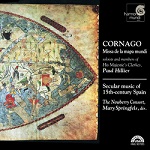
The main interest is Cornago’s Missa de la mapa mundi; this three-part
Mass is one of the earliest to employ a secular tune as its cantus
firmus – the earliest of all, it appears, in Spain. This is likely
to be the only recording of the Mass ever to be made and it’s well worth
having, as is the secular music which completes the album.
The text of the Ordinary of the Mass is easy enough to find, as are
some of the better-known songs, such as Nunca fue pena maior and Niña y viña, but it’s a shame that there’s no booklet.
Heinrich SCHÜTZ (1585-1672)
Ich weiss, dass mein Erlöser lebet, SWV457 [4:29]
Christ ist erstanden von der Marter alle, SWV470 [5:15]
Historia der frölichen und siegreichen Aufferstehung unsers einigen
Erlösers und Seligmachers Jesu Christi, Op.3, SWV50 (Story of the
Resurrection) [40:44]
Cantate Domino canticum novum, SWV463 [2:26]
Surrexit pastor bonus, SWV469 [4:13]
Es gingen zweene Menschen hinauf, SWV444 [3:28]
Ludger Remy (organ), Gerlinde Sämann (soprano), Stefan Kunath (alto),
Georg Poplutz (tenor), Hille Perl (viola da gamba), Lee Santana (lute),
Marie Luise Werneburg (soprano), Isabel Jantschek (soprano), Tobias
Mäthger (tenor), Oliver Kaden (tenor), Cenek Svoboda (tenor), Felix
Rumpf (bass), Felix Schwandtke (bass), Martin Schicketanz (bass), Margret
Baumgartl (violin), Maria Stosiek (soprano)
Dresdner Kammerchor; Sirius Viols, Instrumenta Musica/Hans-Christoph
Rademann
CARUS 83.256 [60:35] – from eclassical.com (mp3 and lossless, no booklet) or stream from Naxos Music Library.
 Carus
already had a recording of the Auferstehungshistorie; presumably
its replacement is due mainly to the fact that the new release forms
Volume 8 of their current series of Schütz recordings. I liked their
recording of Geistliche Chormusik (83.252) in DL
News 2013/2 and its successor is just as recommendable. If anything,
the inclusion of the Auferstehungshistorie, one of the major
works of Schütz’s output, and the fact that the other works are also
related to the Easter theme make the new recording even more desirable,
though the DaCapo recording with Paul Hillier at the helm just maintains
its position at the top of the tree and there’s an intriguing budget-price
7-CD Ricercar set of music for Holy Week and Easter which also includes
this work (RIC344 – see my recent review of music on the Outhere labels). The ceremonial chanting of the title
sounds slightly less grand than on other recordings but the greater
intimacy of the music-making amply compensates.
Carus
already had a recording of the Auferstehungshistorie; presumably
its replacement is due mainly to the fact that the new release forms
Volume 8 of their current series of Schütz recordings. I liked their
recording of Geistliche Chormusik (83.252) in DL
News 2013/2 and its successor is just as recommendable. If anything,
the inclusion of the Auferstehungshistorie, one of the major
works of Schütz’s output, and the fact that the other works are also
related to the Easter theme make the new recording even more desirable,
though the DaCapo recording with Paul Hillier at the helm just maintains
its position at the top of the tree and there’s an intriguing budget-price
7-CD Ricercar set of music for Holy Week and Easter which also includes
this work (RIC344 – see my recent review of music on the Outhere labels). The ceremonial chanting of the title
sounds slightly less grand than on other recordings but the greater
intimacy of the music-making amply compensates.
There is no booklet, which creates a problem with texts – that of the Auferstehungshistorie is not hard to find online – in German here – and Cantate Domino is the Latin text of Psalm 149, but you
may find the other texts problematical. Naxos Music Library, who provided
a booklet for the earlier volume, offer only the details on the back
of the CD.
Matthew LOCKE (c.1621–1677)
Suite in G from Tripla Concordia [9:23]
The Broken Consort, Part 1 (Suites 1-6) [46:51]
Suite in e minor from Tripla Concordia [11:18]
Wayward Sisters (Beth Wenstrom (Baroque Violin), Anne Timberlake (Recorders),
Anna Steinhoff (Baroque Cello), John Lenti (Theorbo)
rec. St John Chrysostom Church, Newmarket, Ontario, Canada, 22–25 July
2012
NAXOS 8.573020 [67:43] – from classicsonline.com (mp3 and lossless)
or stream from Naxos Music Library
The Trio Sonata in 17th-Century England
Orlando GIBBONS (1583-1625) Three Fantasias á 3 (c.1620) [7:48]
John COPRARIO (1570?-1626) Fantasia Suite (1620s) [5:47]
William LAWES (1602-1645) Sett No. 1 (early 1620s) [9:30]
John JENKINS (1592-1678) Fancy and Ayre (c.1650) [9:19]
Fantasia á 3 (c. 1650) [5:04]
Matthew LOCKE (1621-1677) Suite in d minor (Little Consort,
1651) [6:13]
Christopher SIMPSON (1605-1669) Suite in D (c.1650) [9:45]
John BLOW (1649-1708) Sonata in A [5:49]
Ground in g (pre-1695) [3:48]
Henry PURCELL (1659-1695) Sonata XX in D, Z.811 (1697) [5:23]
London Baroque (Ingrid Seifert, Richard Gwilt, (violins), Charles Medlam
(bass viol), Terence Charlston (harpsichord, chamber organ)
rec. St. Martin’s, East Woodhay, Hampshire, England, October 2002. DDD.
BIS BIS-CD-1455 [70:15] – from eclassical.com (mp3 and lossless) or stream from Naxos Music Library
A broken consort is not one that needs fixing, but one for a mixture
of instruments as opposed to a viol consort. Such a consort was originally
intended for outdoor performance, like that which greets Sir Guyon in
the Bower of Bliss in Spenser’s Fairy Queene:
Eftsoones they heard a most melodious Sound,
Of all that mote delight a daintie eare, …
For, all that pleasing is to living eare,
Was there consorted in one harmonee,
Birds, voyces, instruments, windes, waters, all agree. [II.xii.70]

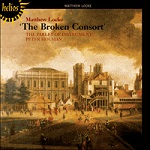 The
alternative theory propounded in the Oxford Companion to Music, that
‘broken consort’ applies to music divided into sets of variations, seems
not to apply to Locke’s music here. John Lenti’s notes subscribe to
the traditional explanation.
The
alternative theory propounded in the Oxford Companion to Music, that
‘broken consort’ applies to music divided into sets of variations, seems
not to apply to Locke’s music here. John Lenti’s notes subscribe to
the traditional explanation.
I can’t claim that it’s a masterpiece by a neglected genius but it’s
enjoyable music from an older contemporary of Purcell whose work deserves
to be better known and it’s attractively performed and recorded on the Naxos recording which marks the début on CD of Wayward Sisters,
winners of the 2011 Early Music America/Naxos Recording Competition.
There are only two other recordings of the Broken Consort, one
of which offers the work complete on two CDs – perhaps Naxos have a
sequel up their sleeves? That recording by the eponymous Locke Consort
on Metronome, which also contains music from Tripla Concordia,
is available from amazon.co.uk on
CD and as a download.
The other contains just Part 1 together with a selection of Duos (Hyperion
Helios CDH55255: The Parley of Instruments/Peter Holman). At
£4.99 for mp3 or lossless download or £5.50 on CD from hyperion-records.co.uk it’s even less expensive than the Naxos and equally enjoyable.
Like all lossless downloads from classicsonline.com, the flac version
of the Naxos comes as one unbroken file – even less appropriate for
a recording of a broken consort than usual and my only grumble about
this recording.
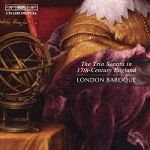 There’s
no overlap with the one work by Locke on the BIS recording but
I recommend that with some caution because Paul Shoemaker was not the
slightest bit in love with it – review. De gustibus non est disputandum because I found it just as enjoyable
as the Naxos, if not even more so, and it comes in lossless sound from
eclassical.com which doesn’t have to be digested in one lump. They offer
the Naxos recording, too, with tracks divided, but at $12.16, which
is hardly competitive with the CD let alone the COL download. Try the
BIS first if you can from Naxos Music Library.
There’s
no overlap with the one work by Locke on the BIS recording but
I recommend that with some caution because Paul Shoemaker was not the
slightest bit in love with it – review. De gustibus non est disputandum because I found it just as enjoyable
as the Naxos, if not even more so, and it comes in lossless sound from
eclassical.com which doesn’t have to be digested in one lump. They offer
the Naxos recording, too, with tracks divided, but at $12.16, which
is hardly competitive with the CD let alone the COL download. Try the
BIS first if you can from Naxos Music Library.
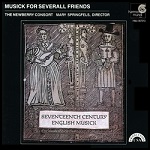 Locke’s
Suite in g minor is included alongside an attractive collection of 17th-century
English theatre music on Musick for Severall Friends, performed
by The Newberry Consort/Mary Springfels on Harmonia Mundi HMU907013 [60:45] – no longer available on CD, with one hopeful seller asking
$213.90 for a copy of the budget (!) Harmonia Mundi d’Abord reissue
on Amazon, but available to download in mp3 and lossless for a fraction
of that price from eclassical.com or stream from Naxos Music Library.
Locke’s
Suite in g minor is included alongside an attractive collection of 17th-century
English theatre music on Musick for Severall Friends, performed
by The Newberry Consort/Mary Springfels on Harmonia Mundi HMU907013 [60:45] – no longer available on CD, with one hopeful seller asking
$213.90 for a copy of the budget (!) Harmonia Mundi d’Abord reissue
on Amazon, but available to download in mp3 and lossless for a fraction
of that price from eclassical.com or stream from Naxos Music Library.

During a large chunk of Locke’s creative life, in the Commonwealth period,
church music was forbidden, but he made up in the decade and a half
that remained to him after the Restoration. Hyperion in 1989 recorded
a number of his Anthems, Motets and Ceremonial Music with New
College College Choir, Oxford; The Parley of Instruments/Edward Higginbottom,
reissued at budget price on Helios CDH55250.
If anything, Ian Bailey under-praises the quality of the performances
– review.
Try track 4, a setting of O be joyful almost worthy of Purcell.
Download in mp3 or lossless, with booklet, from hyperion-records.co.uk.
Le Jardin de Monsieur Rameau
Excerpts of vocal works by
André CAMPRA (1660-1744)
Michel Pignolet de MONTÉCLAIR (1667-1737)
Nicolas Racot de GRANDVAL (1676-1753)
Jean-Philippe RAMEAU (1683-1764)
Antoine d’AUVERGNE (1713-1797)
Christoph Willibald GLUCK (1714-1787)
‘Le Jardin des Voix’, Les Arts Florissants’ academy for young singers
– 2013 edition;
Les Arts Florissants/William Christie and Paul Agnew
rec. Salle Colonne, Paris, 29-31 March 2013. DDD
pdf booklet with texts and translations included
LES ARTS FLORISSANTS AF002 [80:50] – from eclassical.com (mp3, 16- and 24-bit lossless) or stream from Naxos Music Library

The second release on Les Arts Florissants’ new label comes from the
2013 edition of their annual collaboration with young singers under
the title ‘Le Jardin des Voix’.
Having heard previous years’ programmes on BBC Radio 3, I knew that
no allowances would have to be made for the comparative lack of experience
of these young performers. Make a note of their names and watch out
for future appearances: Daniela Skorka (soprano), Emilie Renard (mezzo),
Benedetta Mazzucato (contralto), Zachary Wilder (tenor), Victor Sicard
(baritone) and Cyril Costanzo (bass). Then settle back for an hour and
twenty minutes of delight.
One small grumble – at 80:50 the programme is too generous to burn to
one CD unless you settle for mp3 quality.
Antonio CALDARA (1671?–1736)
Requiem [40:03]
Trio Sonata in e minor, Op.1/5 (1693) for two violins and continuo [7:59]
Sonata in A, No.15 (1735) [10:13]
Missa dolorosa (1735): Sanctus [1:01]; Benedictus [1:53]; Agnus Dei [3:24]
Musica Fiorita/Daniela Dolci (organ, harpsichord)
rec. Adullam Chapel, Basel, Switzerland, November 2011. DDD
pdf booklet with texts and translations included
PAN CLASSICS PC10296 [64:34] – from classicsonline.com (mp3) or stream from Naxos Music Library
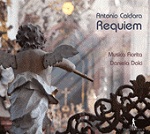 This
appears to be the only available recording of Caldara’s Requiem.
Despite the sober nature of the words, his music is often very beautiful.
Though composed by an Italian, the style is often closer to that of
Charpentier and his French contemporaries. All that exists has been
edited and is performed here with the Sanctus, Benedictus and Agnus Dei of another sober Mass by Caldara added to complete
the programme. The performance is good but not exceptional, the recording
bright and clear and the booklet helpful.
This
appears to be the only available recording of Caldara’s Requiem.
Despite the sober nature of the words, his music is often very beautiful.
Though composed by an Italian, the style is often closer to that of
Charpentier and his French contemporaries. All that exists has been
edited and is performed here with the Sanctus, Benedictus and Agnus Dei of another sober Mass by Caldara added to complete
the programme. The performance is good but not exceptional, the recording
bright and clear and the booklet helpful.
If you wish to hear the Requiem continuosly you will need to
re-programme the tracks – after the Introit and Kyries the Trio
Sonata in A intervenes before the Dies Iræ and a further Sonata
is played before the three sections of the Missa Dolorosa.
A cautionary note: some of the tracks downloaded in an incomplete form
the first time but classicsonline.com make the download available for
a further 30 days and the download was fine the second time around.
All download sites should follow such a policy or even, as eclassical.com
and theclassicalshop.com do, make them permanently accessible, with
an option also to return for mp3 if you purchased a lossless version.
 Johann
Sebastian BACH (1685-1750)
Johann
Sebastian BACH (1685-1750)
Lutheran Masses Volume 2 (BWV236 and 234), with Cantata No.79
The Sixteen/Harry Christophers
CORO COR16120 [73:51] – from thesixteendigital.com (mp3, aac and lossless, with pdf booklet containing texts and translations)
Please see my review on the main MusicWeb International pages for full details – also DL
News 2013/14 for Volume 1 on COR16115.
George Frideric HANDEL (1685-1759) Duetti da Camera
Sono liete, fortunate, HWV194 [4:07]
Troppo cruda, troppo fiera, HWV198 [7:28]
Beato in ver chi può, HWV181 [7:07]
Tanti strali al sen mi scocchi, HWV197 [7:53]
Langue, geme e sospira, HWV188 [5:09]
Conservate, raddioppiate, HWV185 [3:46]
Se tu non lasci amore, HWV193 [6:26]
A miravi io son intento, HWV178 [8:49]
No, di voi non vuo fidarmi, HWV190 [6:42]
Fronda leggiera e mobile, HWV186 [7:04]
Roberta Invernizzi (soprano), Marina De Liso (mezzo), Caterina Dell’Agnello
(cello), Craig Marchitelli (archlute and theorbo), Fabio Bonizzoni (harpsichord)
La Risonanza
Rec. Milan, November 2013. DDD
GLOSSA GCD921516 [64:41] – from eclassical.com (mp3 and lossless, no booklet) or stream from Naxos Music Library (back
cover only)
 I’ve
been pretty ecstatic about the earlier releases in this series on which
Roberta Invernizzi and Fabio Bonizzoni have featured and their contributions
here are just as fine as before … but I’m sorry to say that I’m less
taken with Marina De Liso’s singing or, at least, with the way that
her voice blends with Invernizzi’s. It’s probably the latter, because
I enjoyed her performance as Alcina in Vivaldi’s Orlando Furioso (CPO 7770952 – review).
There she exhibits none of the plumminess which sometimes afflicts mezzos,
but here the contrast with Invernizzi’s pure tones brought that p word
to mind.
I’ve
been pretty ecstatic about the earlier releases in this series on which
Roberta Invernizzi and Fabio Bonizzoni have featured and their contributions
here are just as fine as before … but I’m sorry to say that I’m less
taken with Marina De Liso’s singing or, at least, with the way that
her voice blends with Invernizzi’s. It’s probably the latter, because
I enjoyed her performance as Alcina in Vivaldi’s Orlando Furioso (CPO 7770952 – review).
There she exhibits none of the plumminess which sometimes afflicts mezzos,
but here the contrast with Invernizzi’s pure tones brought that p word
to mind.
There is, nevertheless, much to enjoy on this new release. The music
which Handel wrote in Rome is utterly delightful, even if it lacks the
depth of his later works, and I’m pleased that Glossa are continuing
to quarry it. Emma Kirkby remains my first love in Handel (BIS and Decca
Eloquence) but Invernizzi and Bonizzoni offer strong challenges and
cover more ground.
George Frideric HANDEL (1685-1759) Peace and Celebration
Zadok the Priest, HWV259 [5:36]
Let thy hand be strengthened, HWV258 [8:02]
Concerto grosso Op.3/2, HWV313 [9:57]
My heart is inditing, HWV261 [10:50]
Ode for the Birthday of Queen Anne, HWV74 [25:13]
The King shall rejoice, HWV260 [9:57]
Choir of Claire College Cambridge
European Union Baroque Orchestra/Lars Ulrik Mortensen
rec. live St John’s Smith Square, London, 3 September 2013. DDD
pdf booklet with texts included.
OBSIDIAN CD711 [69:30] – from classicsonline.com (mp3) or stream from Naxos Music Library
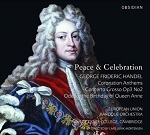 This
live recording celebrates the 300th anniversary of the accession of
George I, the first of the Hanoverian monarchs, in 1714. Handel had
hardly arrived in London and composed the beautiful Ode for the Birthday
of Queen Anne, Eternal Source of Light Divine, than her reign
was over. His old employer, George the Elector of Hannover, was invited
to succeed her and Handel was busy composing the anthems for the new
King’s coronation. What, therefore, at first sight looks like a hotch-potch
of mainly vocal works begins to make sense on that basis.
This
live recording celebrates the 300th anniversary of the accession of
George I, the first of the Hanoverian monarchs, in 1714. Handel had
hardly arrived in London and composed the beautiful Ode for the Birthday
of Queen Anne, Eternal Source of Light Divine, than her reign
was over. His old employer, George the Elector of Hannover, was invited
to succeed her and Handel was busy composing the anthems for the new
King’s coronation. What, therefore, at first sight looks like a hotch-potch
of mainly vocal works begins to make sense on that basis.
Though the actual performance at the coronation was reportedly under-rehearsed
and ‘all in confusion’, there are several highly recommendable recordings
of these anthems to suit all tastes and all choices of coupling, from
the classic King’s/Willcocks (budget-price Double Decca 4550412)
to more recent and more ‘authentic’ versions from Simon Preston (budget-price
Double Decca 4784591), The Sixteen (Coro COR16066), Trevor
Pinnock (mid-price DG 4472802 or budget-price DG Virtuoso 4785183)
and Robert King (Hyperion CDA66350).
Without in any way detracting from my enjoyment and recommendation of
all these, the new Obsidian now joins them – and adds to my appreciation
of the achievements of this still comparatively new label. The Concerto
grosso, Op.3/2, another early work from Handel’s time in London, forms
an attractive interval between the choral items. It’s just a shame that
it duplicates part of Lars Ulrik Mortensen’s recent complete recording
of Op.3 for CPO (7774882) which Michael Greenhalgh described
as ‘state of the art’ – review.
The recording is very good, with little sense of audience presence and
no applause, even at the very end.
Francesco GEMINIANI (1687-1762)
Twelve Concerti Grossi after Arcangelo Corelli’s Sonatas, Op.5
Ensemble 415/Chiara Banchini
rec. c.2003. DDD.
ZIG ZAG TERRITOIRES ZZT040301 [57:08 + 59:19] – from classicsonline.com (mp3) or stream from Naxos Music Library
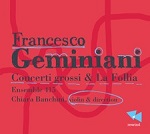
I reviewed this recording in DL
News 2013/4. Selections from it have now been released less expensively
on Outhere’s new Rewind series and these may prove enough for many readers: REW521 contains Concertos Nos. 1, 10, 3, 8, 5, 11 and 12 (La
Folia) [68:59]. The CD can be obtained from outhere-music.com for 9 Euros but the classicsonline.com download of the whole set also
remains attractive.
Since I reviewed the complete Banchini set, eclassical.com have restored the equally desirable Harmonia Mundi complete set (907261/62:
AAM/Andrew Manze, with Cello Sonata Op.5/2 and Violin and Cello Sonata,
Op.5/9 [143:52]) in mp3 and lossless sound.
Discovery of the Month
Johann Georg REUTTER (1708-1772)
Portus Felicitatis : Motets and Arias for the Pantaleon
Aria Venga l’età vetusta (from La magnanimità di Alessandro,
1729) [6:59]
Mottetto de ominibus Sanctis (Motet for All Saints) Justorum
animae in manu Dei sunt (1732) [5:34]
Pizzicato [5:29]
Aria Dura legge a chi t’adora (from Archidamia, 1727)
[7:20]
Allegro [3:20]
Mottetto de quovis Sancto vel Sancta (Motet for any male or female
saint) Hodie in ecclesia sanctorum (1753?) [7:37]
Mottetto de Sancto Wenceslau (Motet for St Wenceslaus) Wenceslaum
Sanctissimum (1752?) [5:09]
Aria Del pari infeconda (from La Betulia liberata, 1734)
[6:42]
Mottetto de Resurrectione Domini (Easter motet) Surrexit Pastor
bonus (1748?) [8:13]
Mottetto de Sanctissima Trinitate (Motet for Trinity Sunday) Deus Pater paraclytus (1744?) [6:21]
Aria Soletto al mio caro (from Alcide trasformato in dio,
1729) [6:45]
Monika Mauch (soprano); Stanislava Jirku (alto)
La Gioia Armonica (Meret Lüthi, Sabine Stoffer (violins), Lucile Chionchini
(viola), Felix Knecht (cello), Armin Bereuter (violone), Margit Übellacker
(dulcimer), Michael Freimuth (archlute, theorbo), Jürgen Banholzer (organ,
direction))
rec. Senedsaal, Bremen, Germany, May 2012. DDD
pdf booklet with texts and translations included
RAMÉE RAM1302 [69:36] – from eclassical.com (mp3 and lossless)

 Reutter’s
music has been unjustly neglected – how often have I written those words
about a composer? Don’t expect the discovery of an unknown genius but
this is one of only two recordings entirely devoted to him and he deserves
more than that. The other is on Accent ACC24275, which I reviewed in 2013. I had some small reservations about the singing on that CD
and, unfortunately, there are four overlaps between it and the present
recording. The new album is more varied in that it includes both sacred
and secular works and I enjoyed the solo singing more.
Reutter’s
music has been unjustly neglected – how often have I written those words
about a composer? Don’t expect the discovery of an unknown genius but
this is one of only two recordings entirely devoted to him and he deserves
more than that. The other is on Accent ACC24275, which I reviewed in 2013. I had some small reservations about the singing on that CD
and, unfortunately, there are four overlaps between it and the present
recording. The new album is more varied in that it includes both sacred
and secular works and I enjoyed the solo singing more.
The word Pantaleon in the sub-title refers to the maker of that name,
Pantaleon Herbenstreit, who produced a perfected model of the psaltery
or dulcimer, an instrument which features in Reutter’s music, around
the year 1700. Reutter specified its use with the soprano arias and
Margit Übellacker also uses it for the instrumental interludes. With
that special selling point, combined with my preference for the singing,
this new Ramée release would be my first choice.
In case you are wondering, the strange object on the cover is a chamberlain’s
key.
There’s an earlier Ramée album featuring these artists in the music
of Antonio Caldara (1670-1736), available with pdf booklet from classicsonline.com or for streaming from Naxos Music Library (RAM0405). Music with
trombones by Antonio Caldara, Johann Josef Fux (c.1660-1741)
and other baroque composers can be found on Fede e Amor (RAM1304:
Alex Potter (counter-tenor) and Ensemble La Fontaine). Download in mp3
and lossless, with pdf booklet, from emusic.com.
Franz SCHUBERT (1797–1828)
Piano Sonata in B-flat, Op. post., D960 (1828) [39:05]
Du bist die Ruh, D776 (1823), No. 3 from Vier Lieder,
Op.59, transcribed for piano by Franz Liszt (1811 – 1886) [6:39]
Ungeduld, D795 (1823), No. 7 from Die schöne Müllerin,
Op.25, transcribed for piano by Franz Liszt [2:15]
Fantasy in C, Op.15, D 760, ‘Wandererfantasie’ (Wanderer Fantasy)
(1822) [20:53]
Barry Douglas (piano)
pdf booklet available
CHANDOS CHAN10807 [69:15] – from theclassicalshop.net (mp3, 16- and 24-bit lossless) or stream from Naxos Music Library
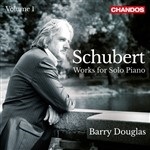 No
half measures for Barry Douglas on his début Schubert album for Chandos
– he goes straight for the jugular with the wonderful Piano Sonata,
D960 and the Wanderer Fantasy, no less, throwing in a couple
of Liszt transcriptions of Lieder for good measure. Among my several
Schubert heroes, the hero of heroes in D960 is Clifford Curzon (Decca E4750842 – download only – or 23-CD set 4784389*), with
Alfred Brendel (the 1972 version, coupled with the Wanderer Fantasia,
Philips 4206442 - download only), Stephen Hough (Hyperion CDA67027)
and Stephen Kovacevich (HyperionCDA67027 or, even better, EMI
if you can find it **) not far behind, as summed up in my June
2012/1 DL Roundup.
No
half measures for Barry Douglas on his début Schubert album for Chandos
– he goes straight for the jugular with the wonderful Piano Sonata,
D960 and the Wanderer Fantasy, no less, throwing in a couple
of Liszt transcriptions of Lieder for good measure. Among my several
Schubert heroes, the hero of heroes in D960 is Clifford Curzon (Decca E4750842 – download only – or 23-CD set 4784389*), with
Alfred Brendel (the 1972 version, coupled with the Wanderer Fantasia,
Philips 4206442 - download only), Stephen Hough (Hyperion CDA67027)
and Stephen Kovacevich (HyperionCDA67027 or, even better, EMI
if you can find it **) not far behind, as summed up in my June
2012/1 DL Roundup.
* earlier 22-CD set from 7digital.com for £28.99.
** the download from classicsonline.com is rather pricey at £8.99 -
£1 more than usual for the label – perhaps because the CD seems to be
unavailable.
Against such strong competition Douglas acquits himself very well, though
I don’t think he quite dislodges my top choices. At 8:02 his tempo for
the second movement strikes me as just a little too fast to capture
the emotion, but it is marked andante sostenuto, so it may be
that for many that fits the bill rather than Curzon’s 9:16, Kovacvich’s
(Hyperion) 9:24 (9:28 on EMI) or Hough’s 10:32. Perhaps my heroes and
I were looking for something a little closer to the slow movement of
the C-major String Quintet here than the music should bear. (I say should,
because it certainly can and does at their hands.)
Douglas is a trifle fast in the finale, too, at 7:46, and here I think
that Schubert’s marking, allegro ma non troppo – presto, and
the sense of the music are better served by a slightly slower tempo
– until you turn to Curzon, who, at 7:38, is slightly faster still,
yet manages not to sound fast. It’s that inexplicable magic that
Curzon shared with the likes of Beecham at work here. Ars ut artem
falleret.
With a powerful and satisfying Wanderer Fantasia – but, again,
not quite the top recommendation – I find myself agreeing with Dominy
Clements – review – that this marks a very promising start to a series worth following
even if each of us has other favourites. For DC, that’s Paul Lewis in
the Fantasia; I remain happy with Brendel’s coupling of D960
or D760 (see above).
Fans of the fortepiano – and I’ve become something of a convert in recent
years – will be interested in Paul Badura-Skoda’s 9-CD cycle on a variety
of period instruments dating from c.1810 to c.1846 on the Arcana label
(A364, around £30, also available on three 3-CD sets). Download
from iTunes (£24.99). Unfortunately the press release which I received from Outhere
includes only the first CD of the set, Nos.1, 9 and 2, so I haven’t
been able to hear his version of No.21 for comparison with Barry Douglas.
The Arcana recordings have produced some very mixed reactions – two
reviewers from the same magazine gave 2-stars and four-stars to the
performances on one of the constituent 3-CD sets.
Kirk McElhearn, whom I’m very pleased to welcome on board DL News, thought
the first set (A408) ‘…an essential recording of some of Schubert’s
piano sonatas. Both Badura-Skoda’s virile and sensitive performances
and the quality of the instruments he chose to record make this a delight
to listen to. If you are unfamiliar with Schubert’s piano music as he
wrote it (on the same type of instrument he used) then this set is a
must.’ That sums up my response to what I have heard, though I got a
little worried at his approach to the finale of Sonata No.2 where he
seems determined to knock nine bells out of an instrument that sounds
as if it’s falling apart under the strain.
Anton BRUCKNER (1824-1896)
Symphony No.9 in d minor, WAB109 (ed. Nowak) [67:10]
London Symphony Orchestra/Bernard Haitink
rec. live, Barbican Centre, London, February 2013. DDD
LSO LIVE LSO0746 [67:10] – from emusic.com (mp3)
 Considering
that the most recent recording of Bruckner’s Ninth that I heard was
from Simon Rattle conducting the BPO on EMI in the four-movement completion,
could I enjoy the three-movement skeleton again? Rattle certainly convinced
Ralph Moore – review: Recording of the Month – and myself – DL
Roundup June 2012/2 – though John Quinn was rather less persuaded
– review.
Considering
that the most recent recording of Bruckner’s Ninth that I heard was
from Simon Rattle conducting the BPO on EMI in the four-movement completion,
could I enjoy the three-movement skeleton again? Rattle certainly convinced
Ralph Moore – review: Recording of the Month – and myself – DL
Roundup June 2012/2 – though John Quinn was rather less persuaded
– review.
Whatever your views on the ‘completed’ version, I don’t think you will
fail to appreciate Bernard Haitink’s new LSO recording of the traditional
unfinished ninth, one of the best of the many that I have heard since
Eugen Jochum’s recording on DG Heliodor (89551, costing in those far-off
days 12/6, £0.63). John Quinn thought this a gripping and magisterial
reading – review – and I can’t quarrel with that.
The download from emusic.com can be yours for £1.26 and the bit-rate
is at a respectable, though not ideal rate of c.225kb/s. While you’re
about it, you can obtain from them Haitink’s Concertgebouw recording
of the Eighth from 2005 for £1.68 (RCO05003 – review).
I must mention one other recording of the three-movement Ninth (ed.
Nowak), from the Saarbrücken RSO and Stanislaw Skrowaczewski on Oehms,
reviewed as part of a 12-CD box set OC207 – here and here – but also available separately on OC218 [61:20] – from eclassical.com (mp3 and lossless) or stream from Naxos Music Library. Skrowaczewski’s
recordings are always well worth hearing – his Brahms Fourth Symphony
with the Hallé, formerly available on IMP, remains one of my benchmarks
for that elusive work – and his Bruckner especially so. The orchestra
may not be world class and even as a download this is more expensive
now than when it was available on CD for £4.99, but it’s well worth
considering.
Johannes BRAHMS (1833-1897) String Quintets
String Quintet No.1 in F, Op.88 [26:47]
String Quintet No.2 in G, Op.111 [30:09]
Takács Quartet, Lawrence Power (viola)
rec. Concert Hall, Wyastone Estate, Monmouth, United Kingdom, May 2013
pdf booklet included.
HYPERION CDA67900 [56:56] – from hyperion-records.co.uk (mp3, 16- and 24-bit lossless)
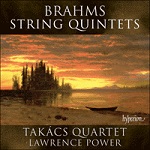 Though
Brahms thought that his inspiration was running out when he produced
the second quintet, this is music that ought to be as well known as
the Piano and Clarinet Quintets and hitherto I’ve thought that the Nash
Ensemble on Onyx were just the team to achieve that. (ONYX4043 – October
2009 DL Roundup). The new recording from the Takács Quartet and
Lawrence Power is at least as good – performance-wise the two go head-to-head
for top spot – and the recording quality is much better than the variable
bit-rate mp3 from emusic.com in which I heard the Onyx.
Though
Brahms thought that his inspiration was running out when he produced
the second quintet, this is music that ought to be as well known as
the Piano and Clarinet Quintets and hitherto I’ve thought that the Nash
Ensemble on Onyx were just the team to achieve that. (ONYX4043 – October
2009 DL Roundup). The new recording from the Takács Quartet and
Lawrence Power is at least as good – performance-wise the two go head-to-head
for top spot – and the recording quality is much better than the variable
bit-rate mp3 from emusic.com in which I heard the Onyx.
I don’t recall ever hearing the Takács Quartet put a foot – or a bow
– wrong on their many recordings for Decca and Hyperion and they haven’t
broken their fine record this time, either. Perhaps the sunset scene
on the cover makes us listen for a farewell mood in the Second Quintet
in particular but there’s nothing wan or valedictory about this performance.
Try the adagio of the Second Quintet on the free sampler, HYP201404,
if you need to be persuaded.
Johannes BRAHMS (1833-1897)
String Quartet in a minor, Op.51/2 [36:35]
Clarinet Quintet in b minor, Op.115* [39:03]
Michael Collins (clarinet)*
Brodsky Quartet (Daniel Rowland, Ian Belton (violin), Paul Cassidy (viola),
Jacqueline Thomas (cello)
pdf booklet available
rec. Britten Studio, Snape Maltings Concert Hall, Snape, Suffolk, 12–14
November 2013. DDD
CHANDOS CHAN10817 [75:40] – from theclassicalshop.net (mp3, 16- and 24-bit lossless)
 My
benchmark for the Clarinet Quintet comes, like the new String Quintets
album above, from Hyperion – Thea King and the Gabrieli Quartet (CDA66107,
with Clarinet Trio), though I also liked the more recent Harmonia Mundi
SACD from Jon Manasse and the Tokyo Quartet (HMU807588, with
Piano Quintet), which those who like their Brahms to be mellow may prefer
– see comparison in 2012/21
DL News.
My
benchmark for the Clarinet Quintet comes, like the new String Quintets
album above, from Hyperion – Thea King and the Gabrieli Quartet (CDA66107,
with Clarinet Trio), though I also liked the more recent Harmonia Mundi
SACD from Jon Manasse and the Tokyo Quartet (HMU807588, with
Piano Quintet), which those who like their Brahms to be mellow may prefer
– see comparison in 2012/21
DL News.
Now along come Michael Collins and the Brodsky Quartet with a third
variation on the coupling, rather less logical, though the pairing was
also chosen by Karl Leister and the Leipzig Quartet on MDG and by Sharon
Kam and the Jerusalem Quartet on Harmonia Mundi.
It was appropriate to place the Quartet first, saving the later work
till last, though it by no means outshines its predecessor, a powerful
work in its own right and very well performed here. Throughout Brahms’
music run two contrary currents, the energetic power which he inherited
from Beethoven and a melancholy strand all of his own – perhaps occasioned
by his yearning for Clara Schumann or all that strong coffee that he
drank. If this performance of the quartet leans a little more towards
the melancholy than I think ideal, that of the quintet more than makes
up by blending the two elements and does so without Michael Collins
turning the work into a clarinet showpiece. If you want display, look
elsewhere.
If you find the pairing to your liking – and even if you have Op.51/2
otherwise coupled – the Chandos recording now represents a strong challenge
for the Clarinet Quintet. If you have the Takács Quartet recording of
Brahms’ Quartets Op.51/1 and Op.67 (Hyperion CDA67552 – see Hyperion
Top 30), the new coupling is ideal.
Michael Collins’ recital with Michael McHale on CHAN10804 caught
the attention of Albert Lam in DL
News 2014/3; he enjoyed it so much that he recommended Volume 1
of the series, too.
Modest MUSSORGSKY (1839-1881) Pictures from an Exhibition (1872)
(orch. Maurice RAVEL) (1922) [32:12]
Nikolai RIMSKY-KORSAKOV (1844-1908) Scheherazade [44:58]
Orchestre Philharmonique du Luxembourg/Emmanuel Krivine
rec. Grand Auditorium of the Luxembourg Philharmonie, Établissement
Public Salle de Concerts Grande-Duchesse Joséphine Charlotte, 30 April-5
May 2012. DDD
ZIG-ZAG TERRITOIRES ZZT329 [74:23] – from classicsonline.com (mp3)
Maurice RAVEL (1875-1937) Ma Mère L’Oye (Mother Goose)
(Suite, 1911-12) [16:11]
Modest MUSSORGSKY
Pictures from an Exhibition (1872) (orch. Maurice RAVEL) (1922)
[32:15]
Anima Eterna Brugge/Jos Van Immerseel
rec. Concertgebouw Brugge, 17 & 19 January 2013. DDD.
ZIG-ZAG TERRITOIRES ZZT343 [49:27] – from classicsonline.com (mp3 and lossless)

 Two
recent recordings from the same label of the same work, Ravel’s orchestration
of Pictures from an Exhibition, must be something of a record
– no pun intended – even for this much-recorded work. To add to the
oddity, Emmanuel Krivine who has recently been associated with the period
ensemble La Chambre Philharmonique, here conducts the Luxemburg orchestra
of which he has been the director since 2006, while Jos van Immerseel
gives us the Pictures with his period-instrument group.
Two
recent recordings from the same label of the same work, Ravel’s orchestration
of Pictures from an Exhibition, must be something of a record
– no pun intended – even for this much-recorded work. To add to the
oddity, Emmanuel Krivine who has recently been associated with the period
ensemble La Chambre Philharmonique, here conducts the Luxemburg orchestra
of which he has been the director since 2006, while Jos van Immerseel
gives us the Pictures with his period-instrument group.
I have recently been listening to Peter Breiner’s performance of his
own huge-scale orchestration of Pictures on blu-ray audio (Naxos NBD0036 – review)
so I suppose it was inevitable that Jos van Immerseel’s recording
should sound a little tame by comparison and I’m not sure what we gain,
if at all, from hearing ‘period’ instruments in music that is very much
of the twentieth century.
The cool, clean lines of this performance, quite appropriate to the Mère l’Oye Suite, are less effective here and the whole interpretation
is something of a disappointment after the excitement of these same
performers in the Berlioz Symphonie Fantastique (ZZT100101 – review and DL
Roundup May 2010); there lean and mean also equals spooky where
appropriate. The Great Gate of Kiev sounds appropriately grandiose,
with mighty bells tolling, but still less so than from Breiner whose
interpretation is almost on the scale of Antal Doráti’s famous recordings
– mono and stereo – of the 1812 Overture, complete with cannon,
and the BD-A sound the modern equivalent of Mercury’s hi-fi for Doráti.
I’m not sure why Zig-Zag booklet gives the date of the Ravel orchestration
as 1942: their own notes in the Krivine booklet correctly give the date
as 1922.
Emmanuel Krivine whisks us into the gallery with a lively Promenade which sets the tone for a brisk-sounding performance overall, yet, surprisingly,
it’s only one second faster than van Immerseel and the whole work only
three seconds faster. Both are consistently quicker than Breiner – almost
eight minutes overall – yet Krivine gives the music a degree of energy
and, where appropriate, menace, that I found lacking from Immerseel.
I liked it rather better than Brian Reinhart, who dismissed it as a
dud – DL
News 2013/18 – but overall it’s too rushed to make the desired effect.
Scheherazade comes off much better – I enjoyed a wallow in some
very wallowy music – but not enough by a considerable margin to oust
the classic Beecham (Warner, ex EMI) or Reiner (RCA) as my Desert Island
choice. Stokowski fans will find a vintage performance in a decent transfer
on Guild GHCD2403 – see Albert Lam’s review in DL
News 2014/3.
If you’re looking for an exciting version of the Ravel orchestration
of Pictures at a keen price, you need look no further than Lorin
Maazel with the Cleveland Orchestra from 1978, coupled with Night
on a Bare Mountain (Telarc CD80042, around £7.50, or download
as First Impression LIMUHD056 [40:49] for $7.37 from eclassical.com,
mp3 and lossless). From a slightly earlier vintage still, I retain a
soft spot for Ernest Ansermet and the OSR, also with Night on a Bare
Mountain and other works (Decca Eloquence 4800047 – review).
Bargain of the Month
Ralph VAUGHAN WILLIAMS (1872-1958)
The Lark Ascending [14:58]
Fantasia on Greensleeves [4:16]
Fantasia on a Theme of Thomas Tallis [14:48]
Sir Edward ELGAR (1857-1934)
Serenade in e minor, Op.20 [11:17]
Variations on an original Theme (‘Enigma’), Op.36 [31:00]
David Nolan (violin); Royal Liverpool Philharmonic Orchestra; London
Philharmonic Orchestra/Vernon Handley
WARNER/EMI NATIONAL GALLERY COLLECTION 6782712 [76:29] – from sainsburysentertainment.co.uk (mp3) Also available as Classics for
Pleasure 5748802.

 Riches
indeed, for a mere £2.99 and Nectar points, too, for UK buyers. Vernon
‘Todd’ Handley’s Elgar and VW, unfairly relegated even on first release
to mid- and budget-price records by EMI, presumably in favour of his
mentor Sir Adrian Boult, deserves to be much better known. His Elgar
Symphonies (No.1 no longer available; No.2 with Sea Pictures on CFP 5753062) and Vaughan Williams’ Job (7-CD box with
Symphonies, CFP 5757602) are my benchmarks for these works.
Riches
indeed, for a mere £2.99 and Nectar points, too, for UK buyers. Vernon
‘Todd’ Handley’s Elgar and VW, unfairly relegated even on first release
to mid- and budget-price records by EMI, presumably in favour of his
mentor Sir Adrian Boult, deserves to be much better known. His Elgar
Symphonies (No.1 no longer available; No.2 with Sea Pictures on CFP 5753062) and Vaughan Williams’ Job (7-CD box with
Symphonies, CFP 5757602) are my benchmarks for these works.
Whether you choose the National Gallery version or the slightly dearer
CFP, these are superb performances and the 320kb/s sound does them justice.
Classic FM fans looking for The Lark Ascending – top of the Hall
of Fame again, for reasons which I don’t really understand – should
find themselves converted to the equally attractive Greensleeves and the much more profound Tallis fantasias before moving on
to performances of two great Elgar works in performances which yield
little, if anything, to the likes of Boult.
Jean SIBELIUS (1865–1957) Complete Symphonies
Symphony No.1 in e minor, Op.39 [38:35]
Symphony No.4 in a minor, Op.63 [34:49]
Three late Fragments transcribed by Timo Virtanen [2:48]
Symphony No.2 in D, Op.43 [45:46]
Symphony No.5 in E-flat, Op.82 [32:35]
Symphony No.3 in C, Op.52 [28:58]
Symphony No.6 in d minor, Op.104 [28:12]
Symphony No.7 in C, Op.105 [22:12]
BBC Philharmonic/John Storgårds
Rec MediaCity UK, Salford, 18 June 2013 (No.1), 19-20 June 2013 (No.2),
5 September
2012 (No.3), 10 June 2013 (No.4), 14 June 2013 (No.5), 23 October 2012
(No.6), 24 October 2012 (No.7), 11 December 2013 (Three Late Fragments)
Pdf booklet available
CHANDOS CHAN10809 [76:26 + 78:36 + 79:45] – from theclassicalshop.net (mp3 16- and 24-bit lossless)
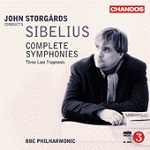 This
offers good value at prices ranging from £15.99 (mp3) to £31.96 (24/96)
but Chandos are in a sense competing with themselves here, since they
also offer from theclassicalshop.net the highly regarded complete Osmo
Vänskä set on BIS (mp3 and 16-bit only) for rather less than their own
new recording. That contains Vänskä’s earlier recordings with the Lahti
orchestra which I still prefer to his remakes from Minnesota and, at
£12.65 (mp3) or £16.20 (lossless) it’s excellent value – paradoxically
less expensive than from BIS’s own site, eclassical.com.
This
offers good value at prices ranging from £15.99 (mp3) to £31.96 (24/96)
but Chandos are in a sense competing with themselves here, since they
also offer from theclassicalshop.net the highly regarded complete Osmo
Vänskä set on BIS (mp3 and 16-bit only) for rather less than their own
new recording. That contains Vänskä’s earlier recordings with the Lahti
orchestra which I still prefer to his remakes from Minnesota and, at
£12.65 (mp3) or £16.20 (lossless) it’s excellent value – paradoxically
less expensive than from BIS’s own site, eclassical.com.
I really need more space than a short review to make detailed comparisons
with Vänskä and other interpreters, which I plan to do in a full review
on the main MusicWeb International pages. Pending that full review I
have been dipping into these recordings and I like what I hear well
enough to regard the new set as offering a strong challenge, with only
minor reservations, to existing preferences. Meanwhile if you wish to
make your own judgement, you’ll find both Storgårds and Vänskä for streaming
from Naxos Music Library.
Bargain lovers should note that theclassicalshop.net also offers Sir
Alexander Gibson’s recordings of the symphonies, still well worth considering,
for £4.80 (mp3) or £4.99 (lossless) each: 1 and 4 on CHAN6555,
2 and 5 on CHAN6556 and 3, 6 and 7 on CHAN6557.
Be sure to choose the Chandos Collect versions which I have highlighted
– the same recordings are still also available at full price. If you’re
happy with mp3, amazon.co.uk have a bargain of bargains in the form of Vänskä’s Lahti
recordings of all the symphonies, Violin Concerto, Lemminkäinen Suite, etc., for £7.49 – even better value for US buyers at $7.99 from amazon.com .
To complicate matters still further, I have only recently and belatedly
caught up with Sir Mark Elder’s recording of Symphonies Nos. 1 and 3
with the Hallé (Hallé CDHLL7514 – review).
These now join the recording of No.2, Oceanides and Pohjola’s
Daughter (CDHLL7516 – review)
on my list of benchmark recordings of the Sibelius symphonies.
Johan (Jean) Christian Julius SIBELIUS (1865–1957)
Lemminkäinen Suite, Op.22 (Four Legends from the Kalevala)
[47:06]
Lemminkäinen and the Maidens of the Island (1896, rev. 1897 &
1939) [14:59]
The Swan of Tuonela (1893, rev. 1897 and 1900) [9:10]
Lemminkäinen in Tuonela (1896, rev. 1897 and 1939) [16:07]
Lemminkäinen’s Return (1896, rev. 1897 and 1900) [6:24]
Skogsrået (The Wood-Nymph, Ballad for Orchestra, 1894/95), Op.
15* [21:37]
Ilkka Pälli (cello)*
Lahti Symphony Orchestra (Sinfonia Lahti)/Osmo Vänskä
rec. Sibelius Hall, Lahti, Finland, November 2006 and October 2007.
DDD/DSD
BIS-SACD-1745 [69:37] - from eclassical.com (mp3 and 16-bit)
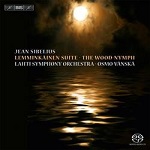 Osmo
Vänskä in Sibelius with the Lahti Symphony Orchestra has to be good
news. Much as I have enjoyed Vänskä’s recent Sibelius symphonies with
the Minnesota Orchestra, I’ve retained a marginal preference for his
older recordings of those works with the Lahti Orchestra, recordings
which I continue to place at or very near the top of the tree. The only
thing that surprised me was that BIS have waited so long to release
this recording; then I realised that most of the components have
been released before, some several times – see below.
Osmo
Vänskä in Sibelius with the Lahti Symphony Orchestra has to be good
news. Much as I have enjoyed Vänskä’s recent Sibelius symphonies with
the Minnesota Orchestra, I’ve retained a marginal preference for his
older recordings of those works with the Lahti Orchestra, recordings
which I continue to place at or very near the top of the tree. The only
thing that surprised me was that BIS have waited so long to release
this recording; then I realised that most of the components have
been released before, some several times – see below.
Vänskä and the Lahti Orchestra had already recorded the Lemminkäinen
Suite for BIS in 1999 and not only does that recording remain available,
it’s a must-have for Sibelius scholars in that it offers the original
versions of Nos. 1 and 4 and alternative sections of Nos. 3 and 4. (BIS-CD-1015 – download in mp3 and lossless from eclassical.com).
Dr. Len Mullenger ended his review of that earlier release ‘this recording
must have a place in every Sibelius collection’ and I’m not about to
argue with that conclusion. If you just want the final version of the
Suite and don’t mind decent mp3, the tremendous bargain collection of
all the symphonies, the Violin Concerto, etc., offered on amazon.co.uk, 7½ hours for just £7.49, contains Vänskä’s earlier recording.
Between 1999 and 2007 Vänskä’s tempi had tightened very slightly – 47:06
overall against 48:47, the difference pretty evenly spread across the
three sections of the Suite. That’s the opposite of what has happened
with the symphonies – see, for example, my review of Nos. 2 and 5 and
Dan Morgan’s take on the same recording in DL
Roundup February 2012/1, where we were both left feeling slightly
underwhelmed by comparison with Vänskä’s earlier recordings, against
the trend of other reviewers who welcomed the new versions more warmly.
Eugene Ormandy’s recording of the Lemminkäinen Suite is slightly
faster still overall – the difference largely accounted for by his fast
tempo in No.3, Lemminkäinen in Tuonela. I liked that recording
and I’m sorry to see that it has gone the way of all EMI Encore CDs.
Even the classicsonline.com download which I recommended is no longer
available, though it can still be streamed from Naxos Music Library
and his 1951 mono version remains available from Naxos Classical Archives,
a powerful set of performances in inevitably dated but tolerable sound.
(9.80530).
Bargain lovers will find very little to fault in a more modern Naxos
recording of the Lemminkäinen Suite, with Finlandia and
the Karelia Suite (8.554265, Iceland SO/Petri Sakari – review).
Sakari takes a broader view of the opening Lemminkäinen and the Maidens – I think the tension slips here just a little – but in the remaining
movements his interpretation is very similar to Vänskä’s, except that
he places Lemminkäinen in Tuonela second and Swan of Tuonela third. It can be yours for £4.99 from classicsonline.com (320 kb/s
mp3, with booklet) and for not much more on CD.
For all the value of the earlier recording, no doubt The Wood Nymph makes a more attractive coupling for the general listener. It doesn’t
receive too many outings – of the nine recordings in the current catalogue,
five are permutations of Vänskä’s recording, two of the piano transcription,
also on BIS, one of the song (Anne Sofie von Otter – BIS again) and
one from Helsinki SO/John Storgårds on Ondine. It receives an excellent
recording here but the same version seems to have appeared already separately
and on collections such as The Sound of Sibelius (BIS-SACD-1645 – review)
and Tone Poems Volume I (BIS-CD-1900/02, with the earlier
recording of Lemminkäinen in original and revised forms and other
works – review).
It’s getting hard to keep up with the permutations which BIS make of
their Sibelius recordings: The Sound of Sibelius contains not
only The Wood Nymph but half of the ‘new’ recording of the Lemminkäinen
Suite.
No doubt BIS wanted to remake the Lemminkäinen Suite in SACD
and 24-bit sound and the new recording certainly sounds stunningly good
in the latter format but it’s really very naughty of them to befuddle
us with a ‘new’ release of which more than half has appeared before.
Discovery of the Month
Paul GRAENER (1872-1944)
Orchestral Works - Volume 1
Comedietta, Op.82 (1928) [9:25]
Variationen über ein russisches Volkslied, Op.55 (1917) [24:26]
Musik am Abend, Op.44 (1913) [14:12]
Sinfonia breve, Op.96 (1932) [17:48]
NDR Radiophilharmonie Hannover/Werner Andreas Albert
rec. Großer Sendesaal, NDR Hannover, 19-23 Jan 2009. DDD
CPO 777447-2 [66:00] - from eclassical.com (mp3 and lossless, no booklet) or stream from Naxos Music Library (with
rudimentary pdf booklet)
Orchestral Works - Volume 2
Symphony in d Minor, Op.39, Schmied Schmerz (1912) [32:34]
Aus dem Reiche des Pan Op.22 (1906-20) [15:17]
Variationen über Prinz Eugen, Op.108 (1939) [16:06]
NDR Radiophilharmonie Hannover/Werner Andreas Albert
rec. Großer Sendesaal, NDR Hannover, 24-28 Jan 2011. DDD
CPO 777679-2 [64:21] - from eclassical.com (mp3 and lossless, no booklet) or stream from Naxos Music Library (with
rudimentary pdf booklet)

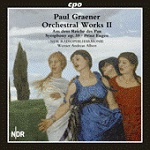

Having heard of Paul Graener as a Nazi stooge – which may or may not
be true; like Furtwängler he served as vice-president of the Reichsmusikkammer – I didn’t recall hearing any of his music until I chanced on these
two recent recordings and was sold.
As Rob Barnett put it in his detailed and informative review the music is well worth hearing again and again. He doesn’t get a mention
in the current Oxford Companion to Music, which is surely an injustice.
Volume 1 is already available to try from Naxos Music Library and Volume
2 should be joining it soon. My only complaint concerns the lack of
a booklet at all from eclassical.com, with only the usual cut-me-down
CPO effort from NML.
Charles IVES (1874-1954) Symphony No. 2 [38:23]
Elliott CARTER (1908-2012) Instances [7:53]
George GERSHWIN (1898-1937) An American in Paris [18:45]
Seattle Symphony Orchestra/Ludovic Morlot
rec. live S. Mark Taper Foundation Auditorium, Benaroya Hall, Seattle,
Washington, USA, 14-17 June, 2012 (Ives), 7-10 February, 2013 (Carter),
and 17, 29 September 1 October, 2011 (Gershwin).
Pdf booklet included
SEATTLE SYMPHONY MEDIA SSM1003 [65:03] – from classicsonline.com (mp3) or stream from Naxos Music Library
Maurice RAVEL (1875-1937)
Alborada del gracioso [7:47]
Pavane pour une infante défunte [6:03]
Rapsodie espagnole [15:28]
Camille SAINT-SAËNS (1835-1921)
Symphony No.3 in c minor, Op.78 (Organ Symphony) [35:00]
Seattle Symphony Orchestra/Ludovic Morlot
rec. live S. Mark Taper Foundation Auditorium, Benaroya Hall, Seattle,
Washington, USA, 19-21 September, 2013 (Ravel), and 27-30 June, 2013
(Saint-Saëns).
pdf booklet included
SEATTLE SYMPHONY MEDIA SSM1002 [64:23] – from eclassical.com (mp3, 16- and 24-bit lossless) or stream from Naxos Music Library
Henri DUTILLEUX (1916-2013)
Symphony No. 1 [30:34]
Tout un monde lointain * [26:36]
The Shadows of Time for 3 Children’s Voices and Orchestra** [21:15]
* Xavier Phillips (cello)
** Benjamin Richardson, Kepler Swanson and Andrew Torgelson (boy sopranos)
Seattle Symphony Orchestra/Ludovic Morolt
rec. live S. Mark Taper Foundation Auditorium, Benaroya Hall, Seattle,
Washington, USA, September, October and November, 2012. DDD
pdf booklet included
SEATTLE SYMPHONY MEDIA SSM1001 [78:29] – from eclassical.com (mp3, 16- and 24-bit lossless)
Three recordings from the latest in-house label, that of the Seattle
Symphony Orchestra.
 The Ravel items have too many fine rivals to list – Jean Martinon
on a budget EMI/Warner twofer 4769602 or budget triple 5008922: Bargain of the Month – review,
will do very well for starters.
The Ravel items have too many fine rivals to list – Jean Martinon
on a budget EMI/Warner twofer 4769602 or budget triple 5008922: Bargain of the Month – review,
will do very well for starters.
Though there is less competition for the Saint-Saëns, Berj Zamkochian
and Charles Munch in Boston (RCA), though elderly, still takes some
beating. The Munch is now available only in a 60-CD box, though the
Living Stereo single-CD, with Debussy La Mer and Ibert Escales:Recording
of the Month – review – review – is available for streaming from Naxos Music Library. There’s a transfer
on Discover Music – yours for just £0.84 from emusic.com – which comes at a low bit-rate of around 160kb/s and sounds rather
thin and one-dimensional.
In the Second Symphony – completed in 1902 but not performed until 1951
– Ives, though not yet the enfant terrible,  was
already speaking with an American accent but the language was still
that of the European Romantic tradition. It’s spacious music and it
requires and receives a spacious performance, complete with what has
been aptly described as the raspberry which Ives blows at the end of
uproarious version of Columbia which ends the finale. The shortened
applause which greets the end is well deserved, but there are three
other performances, all, again, with American orchestras, which are
more logically coupled:
was
already speaking with an American accent but the language was still
that of the European Romantic tradition. It’s spacious music and it
requires and receives a spacious performance, complete with what has
been aptly described as the raspberry which Ives blows at the end of
uproarious version of Columbia which ends the finale. The shortened
applause which greets the end is well deserved, but there are three
other performances, all, again, with American orchestras, which are
more logically coupled:
• Hyperion CDA67525 : Dallas SO/Andrew Litton (with Symphony
No.3 and General William Booth enters Heaven). [68:42] See review by Tony Haywood. Not available for download.
• Naxos 8.559076 : Nashville SO/Kenneth Schermerhorn
(with Robert Browning Overture) [66:28] – from classicsonline.com (mp3) or stream from Naxos Music Library. Gwyn Parry-Jones was not taken
with performance or recording – review – but others have reacted much more positively, even to the extent of
making this the work’s reference recording.
• Chandos CHAN10031 Detroit SO/Neeme Järvi (with
Symphony No.1 – download from theclassicalshop.net (mp3 and lossless). This re-coupling of a recording
original coupled with Creston’s Symphony No.2 (still available on CHAN9390)
comes at an attractive price - £6.00 (mp3) or £7.99 (lossless).
I must pass on the Elliott Carter – it’s not within my comfort zone.
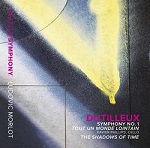 The
only work on the Dutilleux album with which I was at all familiar
was Tout un monde…, with which I had previously failed to engage
in the Rostropovich recording (EMI GROC) and, I’m sorry to say, given
up on – see 2013/16
DL News. Since that premiere recording it’s been recorded by Christian
Poltéra (cello) with ORFSO, Vienna/Jac van Steen (BIS-SACD-1777),
coupled, like the Rostropovich, with Lutoslawski’s Cello Concerto – review.
The
only work on the Dutilleux album with which I was at all familiar
was Tout un monde…, with which I had previously failed to engage
in the Rostropovich recording (EMI GROC) and, I’m sorry to say, given
up on – see 2013/16
DL News. Since that premiere recording it’s been recorded by Christian
Poltéra (cello) with ORFSO, Vienna/Jac van Steen (BIS-SACD-1777),
coupled, like the Rostropovich, with Lutoslawski’s Cello Concerto – review.
Never say never: the new recording gave me more enjoyment than the EMI,
though I’m sure that isn’t the fault of the dedicatee Rostropovich.
Now I must try the BIS.
I enjoyed hearing The Shadows of Time (1995/97), too, so I’m
becoming a Dutilleux convert. How could a fan of Messiaen have passed
his music by? I haven’t heard the recent Esa-Pekka Salonen recording
on DG 4791180, also coupled with Tout un monde …, plus
the first recording ofCorrespondances, though I see that Leslie
Wright made it a Recording of the Month – review – and others have been equally fulsome in their praise, so Dutilleux-ites
will probably already have that recording.
They may prefer the 1992 Chandos recording of the Symphony with BBC
Philharmonic/Yan Pascal Tortelier, a highly regarded account, nominated
for a Gramophone Award (Symphonies 1 and 2, CHAN9194 – from theclassicalshop.net,
mp3 or lossless – or Complete Orchestral Works on CHAN9853).
YORK BOWEN (1884–1961) Chamber Works
Clarinet Sonata in f minor, Op.109 (1943)* [15:31]
Rhapsody Trio in a minor, Op.80 (1925–26) [13:32]
(premiere recording)
Piano Trio in d minor (c.1900, unfinished) [11:06]
Phantasy Quintet in d minor for Bass Clarinet and String Quartet, Op.93
(c. 1933)† [14:11]
Piano Trio in e minor, Op.118 (1946) 24:07
Robert Plane (clarinet*; bass clarinet†)
Gould Piano Trio (Lucy Gould violin†, Alice Neary cello†, Benjamin Frith
piano*) with
Mia Cooper violin†, David Adams viola
CHANDOS CHAN10805 [78:29] – from theclassicalshop.net (mp3, 16- and 24-bit lossless) or stream from Naxos Music Library
(‘All in all, this is an excellent collection of Bowen’s chamber works;
the two clarinet works really surprised me and [made] me keen to hear
more.’ See review by David Barker and review by John Quinn.)

This is another milestone on the road to the rehabilitation of York
Bowen which began with the rediscovery of his concertos (Piano Concertos
3 and 4, Danny Driver and Martyn Brabbins, Hyperion CDA67659;
Viola Concerto, Lawrence Power and Martyn Brabbins, with Forsyth Viola
Concerto, CDA67546 and Violin Concerto and Piano Concerto No.1,
Lorraine McAslan and Michael Dussek with Vernon Handley, Dutton CDLX7169).
I’d start with those earlier recordings but I’d definitely recommend
making this recording of some attractive chamber music your next port
of call.
Other Chandos recordings of Bowen’s music worth including on your shopping
list include his symphonies (CHAN10805) and piano music (CHAN10277, 10410, 10506 and 10593 or 4-CD set CHAN10774(4)X).
It’s one of those absurdities of the economics of the record companies
that the lossless download of the 4-disc set costs more than the CDs.
Walter PISTON (1894-1976)
Concerto No.1 for Violin and Orchestra (1939) [21:37]
Fantasia for Violin and Orchestra (1970) [14:31]
Concerto No.2 for Violin and Orchestra (1960) [24:38]
James Buswell (violin)
National Symphony of Ukraine/Theodore Kuchar
rec. Concert Hall of Ukrainian Radio, Kiev, 27-30 May, 1998. DDD
pdf booklet included
2xHD 2XHDNA2014 [60:46] – from eclassical.com (mp3, 16- and 24-bit lossless) (from Naxos 8.559003)
Samuel BARBER (1910-1981)
The School for Scandal Overture, Op.5 [8:37]
Symphony No.1, Op.9 (in one movement) [21:06]
First Essay for Orchestra, Op.12 [8:11]
Symphony No.2, Op.19 [30:59]
Royal Scottish National Orchestra/Marin Alsop
rec. Henry Wood Hall, Glasgow, Scotland, 8-9 December 1998. DDD
2xHD 2XHDNA2013 [69:15] – from eclassical.com (mp3, 16- and 24-bit)
(from Naxos 8.559024, which also remains available)

 At
the same time as Naxos have made available a number of their recent
recordings in 24-bit sound on blu-ray audio discs, 2xHD have taken a
number of their older recordings and re-mastered them in DSD and 24-bit
sound. The early collaboration between Naxos and Marin Alsop, which
has proved so fruitful, is one of the first and best results.
At
the same time as Naxos have made available a number of their recent
recordings in 24-bit sound on blu-ray audio discs, 2xHD have taken a
number of their older recordings and re-mastered them in DSD and 24-bit
sound. The early collaboration between Naxos and Marin Alsop, which
has proved so fruitful, is one of the first and best results.
I reviewed the Naxos recording of the Barber, downloaded from
classicsonline.com in mp3 in DL
News 2013/15, where I compared it with Charles Dutoit’s recording
(CHAN9684). I thought the latter superior only in that it was
available in lossless sound, an advantage now trumped by the availability
of the Alsop recording in 24-bit sound. With rather more music for your
money, the 2xHD now has the edge, though with eclassical.com’s per-second
charging policy that makes it slightly more expensive in 16-bit than
the Chandos. The 24-bit costs a fairly hefty $18.70, an even greater
premium than the Naxos BD-As, which cost around £10, but the quality
is worth the price.
Of these high-definition transfers of Naxos recordings to 2xHD, the Piston may seem the least obvious candidate for special treatment
but it’s not only the sole extant recording of either of the Piston
concertos in the UK catalogue, it’s also very good. The Naxos policy
of employing little-known Eastern European orchestras, often with better-known
Western soloists and/or conductors – Theodor Kuchar had already made
his reputation in the US before returning to his native Ukraine – really
paid dividends in many cases and this is certainly one of them. Even
if weren’t so good, it has no rivals.
I don’t recall ever having heard any of these works before – Piston’s
reputation for dryness has made me tend to steer clear – but this recording
of the first concerto in particular has endeared itself to me. Not for
nothing has it been likened to the Barber Violin Concerto. Rob Barnett
gave this a 4-star recommendation – review – I’d be inclined to add a fifth if we were still in the star business.
RB also noted the excellent recording quality and this is even more
apparent in the 24-bit download, though again at a fairly hefty premium
over the price of the Naxos CD at $16.41.
The booklets are straight reprints of the Naxos, including the Barber
notes by Richard Whitehouse and those on Piston which include the thoughts
of the soloist, apart from having a larger version of the picture on
the cover of the Barber and a completely different one for the Piston,
plus an explanation of the 2xHD process.
Less outstanding in a very competitive field is the reissue of the Brahms
and Bruch Violin Concertos, Takako Nishizaki (violin) with the Slovak
PO and Stephen Gunzenhauser (2XHDNA2011 – from eclassical.com,
mp3, 16- and 24-bit lossless). If you were looking for a decent inexpensive
recording of the two concertos, you could do much worse than go for
the Naxos original (8.550195), but $17.61 for the 24-bit download
is too steep. Nishizaki’s tone is clear but a little thin and the accompaniments
are very competent. As with most recordings of the Brahms, the first
movement sounds too languid at 24:09 after you have heard Heifetz and
Reiner who take 18:45 (RCA – still my top recommendation).
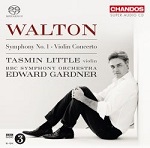 Sir
William WALTON (1902-1983)
Sir
William WALTON (1902-1983)
Symphony No.1 in b-flat minor (1932-35) [43:10]
Violin Concerto (revised 1943) [33:05]
Tasmin Little (violin)
BBC Symphony Orchestra/Edward Gardner
rec. Watford Colosseum, 18 September 2013 (Violin Concerto); Fairfield
Halls, Croydon, 3-4 February 2014 (Symphony No. 1)
CHANDOS CHAN5136 [76:30] – from theclassicalshop.net (mp3, 16- and 24-bit lossless. Also available as SACD.)
Please see my review on the main MusicWeb International pages of these strongly competitive
performances.
Sir Peter MAXWELL DAVIES (b.1934)
Suite from The Boyfriend (1971) [26:11]
Suite from The Devils (1971) [20:23]
Seven In Nomine (1965) [16:18]
The Yellow Cake Revue (1980) (piano interludes) [8:08]
Yesnaby Ground (1980) [2:27]
Farewell to Stromness (1980) [5:41]
Aquarius/Nicholas Cleobury
Peter Maxwell Davies (piano)
Previously released on Collins Classics
rec. EMI Studios, Abbey Road, London, England, October 1989. DDD
pdf booklet included.
NAXOS 8.572408 [70:00] – from eclassical.com (mp3 and lossless) or classicsonline.com (mp3 only) or stream from Naxos Music Library
‘A surprisingly fresh and agreeably discomfiting selection. Try it and
be surprised.’ See review by Rob Barnett
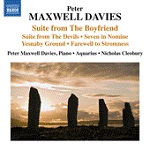 The
two opening works both stem from Max’s work for the theatre and cinema
but whereas the first is light-hearted, The Devils is one of
the toughest works ever screened and neither the film nor the music
is for anyone of a nervous disposition. The opening music – not included
here – was from a recording of renaissance music by David Munrow* but
Max wrote the four items included in the Suite. After that Seven
In Nomine returns us to a gentler sound-world, derived from a Tudor
format but unmistakeably modern in concept.
The
two opening works both stem from Max’s work for the theatre and cinema
but whereas the first is light-hearted, The Devils is one of
the toughest works ever screened and neither the film nor the music
is for anyone of a nervous disposition. The opening music – not included
here – was from a recording of renaissance music by David Munrow* but
Max wrote the four items included in the Suite. After that Seven
In Nomine returns us to a gentler sound-world, derived from a Tudor
format but unmistakeably modern in concept.
The return of this recording, originally from Collins Classics, represents
a very welcome addition to the other recordings from that source which
Naxos has been accessing.
* still available on a Warner/Erato budget twofer, Renaissance Dance,
music by Prætorius, Susato and Morley (3500032, target price
£7.65 or download from 7digital.com for £5.49).
Reissues of the Month
Sir John TAVENER (1944–2013)
Ikon of Light [42:14]
Funeral Ikos [9:41]
The Lamb (conducted by the composer) [3:42]
Great Canon of St Andrew of Crete* [21:55]
*Jeremy White (soloist)
The Tallis Scholars/Peter Phillips
rec. Merton College, Oxford, 1982 and 1984.
pdf booklet with texts and translations included
GIMELL GIMSE404 [77:32] – from gimell.com (mp3 and lossless)
Ikon of Light
A Hymn to the Mother of God 3.26
Hymn for the Dormition of the Mother of God 5.01
The Lamb [3.41]
The Tyger [6.07]
Ikon of Light [41:48]
Today the Virgin [2.49]
Eonia [4.42]
The Sixteen/Harry Christophers
rec. St Michael’s Church, Highgate, London, 1994, in the presence of
the composer
pdf booklet with texts and translations included
CORO COR16116 [67.26] – from thesixteen.com (mp3, aac and lossless) or stream from Naxos Music Library
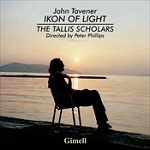

 I
had been hoping for some time that Gimell would reissue this
recording, long available only for streaming from Naxos Music Library;
now here it is at budget price, sadly not to celebrate the composer’s
70th birthday, as intended, but as a fitting memorial to
him. I signalled the reissue some time ago and then, in one of my OAP
moments, forgot that I’d had a pre-release download and missed the release
date, delayed because Gimell didn’t wish to seem to be climbing on the
bandwagon.
I
had been hoping for some time that Gimell would reissue this
recording, long available only for streaming from Naxos Music Library;
now here it is at budget price, sadly not to celebrate the composer’s
70th birthday, as intended, but as a fitting memorial to
him. I signalled the reissue some time ago and then, in one of my OAP
moments, forgot that I’d had a pre-release download and missed the release
date, delayed because Gimell didn’t wish to seem to be climbing on the
bandwagon.
In the event John Quinn was ahead of me and said just about all that
needed to be said – review.
I’ll merely add my recommendation to his and alert you to the fact that
The Tallis Scholars are scheduled to perform Tavener’s Requiem Fragments at the 2014 Proms on the exact centenary of the outbreak of World War
I.
Even if you buy the Gimell recording at its very attractive price, you
should still have the Coro recording, too. Made in the presence
of the composer, this, too would have made a fitting 70th-birthday
tribute as it also now makes a fitting memorial to Tavener’s memory.
